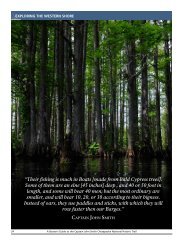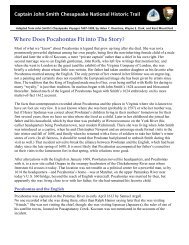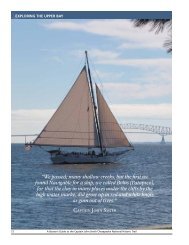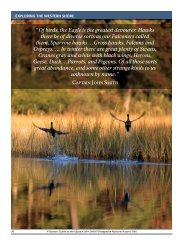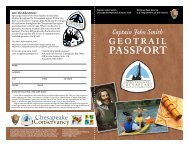Draft Interpretive Plan Join the adventure! - Captain John Smith ...
Draft Interpretive Plan Join the adventure! - Captain John Smith ...
Draft Interpretive Plan Join the adventure! - Captain John Smith ...
You also want an ePaper? Increase the reach of your titles
YUMPU automatically turns print PDFs into web optimized ePapers that Google loves.
*Develop ways to tie interpretation to water based experiences with in-depth guides,<br />
paddling guides to St. Leonard’s Creek and o<strong>the</strong>r ways to interpret from <strong>the</strong> water. Tap<br />
into <strong>the</strong> marina populations and boat clubs (Cruising Club of <strong>the</strong> Chesapeake). Place<br />
interpretive panels in marinas. Develop landings at Jefferson Patterson Park & Museum.<br />
“Connect people through <strong>the</strong> waterways. Return to <strong>the</strong> old ways.” Elder hostel boat<br />
tours. Patuxent and Potomac rivers tour packages.<br />
*Develop a program coordinating scouting events/hikes/paddles/orienteering with<br />
patches/medals.<br />
*Develop additional events tracing <strong>Captain</strong> <strong>Smith</strong>’s voyages.<br />
*Broaden <strong>the</strong> programming of <strong>the</strong> Skipjack Lab of <strong>the</strong> Chesapeake Biological<br />
Laboratories.<br />
*Encourage geocaching (using GPS devices to find “caches” at predetermined sites) at<br />
St. Mary’s River State Park and Point Lookout State Park. (This will require an<br />
agreement from <strong>the</strong> Maryland Department of Natural Resources.)<br />
*Develop kayak and canoe historic tours (Annapolis Maritime Museum has initiated<br />
this).<br />
*Weave CAJO content into Ingleside Winery Tours.<br />
*Develop skiff tours, e.g. Calvert Marine Museum to Jefferson Patterson Park &<br />
Museum. (Note: insurance an issue. Check National Park Service support program.)<br />
*Encourage Heritage Boat Tours (visit sites from water), e.g. Watermark Tours.<br />
8. <strong>Interpretive</strong> Media<br />
Participants recommended <strong>the</strong> types of media <strong>the</strong>y thought would effectively reach<br />
visitors.<br />
Summary:<br />
Recognizing <strong>the</strong> nature of <strong>the</strong> <strong>Captain</strong> <strong>John</strong> <strong>Smith</strong> Chesapeake National Historic<br />
Trail, participants recommended that media be developed to reach out to visitors,<br />
potential visitors and local residents. Websites, cell phone tours, school curriculums,<br />
road signs, buoy system panels, NOAA’s Chesapeake Bay <strong>Interpretive</strong> Buoy System,<br />
guidebooks, radio broadcasts, offsite films and Regional Information Centers were<br />
recommended to communicate to people where <strong>the</strong>y were. Conventional media such as<br />
films or indoor or outdoor exhibits requiring on-site visitor centers were not<br />
recommended.<br />
By <strong>the</strong>ir comments, participants tacitly acknowledge that people would not be<br />
likely to come to <strong>the</strong> Trail until media promotions and Trail interpretation reached<br />
people where <strong>the</strong>y are.<br />
The participants’ creative suggestions for utilizing <strong>the</strong> latest in electronic media<br />
acknowledged <strong>the</strong> need to contact <strong>the</strong> greatest number of people with <strong>the</strong> most efficiency.<br />
Again, planners and managers will have to carefully evaluate <strong>the</strong>se and o<strong>the</strong>r<br />
ideas for interpretive media to get <strong>the</strong> most out of <strong>the</strong> available resources of people and<br />
money.<br />
Specific Suggestions:<br />
101



